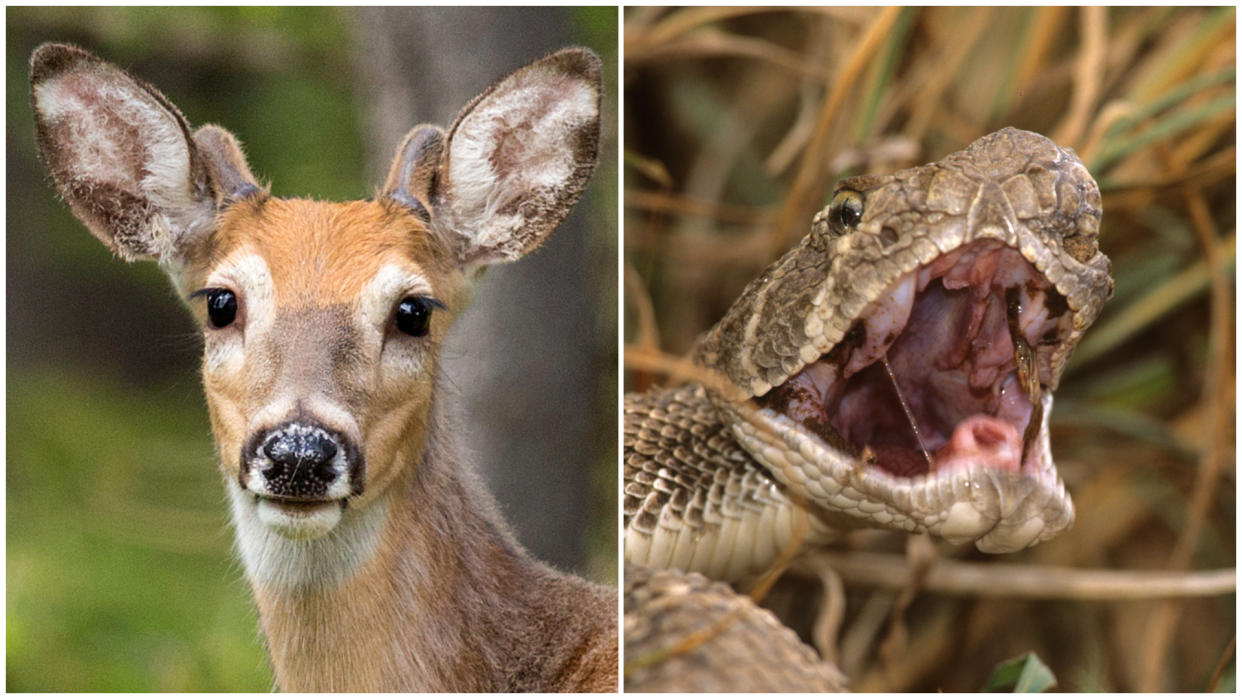Viral video of deer eating a snake isn't as weird as you might think


It makes for disturbing viewing: In a 22-second video shared recently on Instagram, a white-tailed deer locks eyes with the camera as it nonchalantly slurps up a dead snake like it's a strand of spaghetti. The somewhat unnerving scene, filmed by Texas-based Trey Reinhardt, provoked alarm across social media about the deer's diet.
A post shared by Trey Reinhart (@tre_hart)
A photo posted by on
Deer aren't naturally built for catching animals or consuming meat. Instead they extract nutrients from cellulose, the fibrous ingredient that makes up the walls of plant cells, using their intricate four-chambered digestive system, and turn it into energy. But while certainly unusual, carnivorous behavior isn't unheard of. In fact, this creature is one in a surprisingly long line of deer that have shown a taste for blood.
Before the snake-slurper was caught on film, a deer was filmed nibbling on a live fish, eventually swallowing it whole. In other footage, what appears to be a semi-tame deer doesn't think twice before accepting a chunk of steak from an al fresco diner, and gulping it down. Field cameras have captured images of deer seeming to nibble on dead rabbits, and nosing around gut piles left behind by hunters in the wild.
These amount to more than just one-off observations. In 1988, researchers documented red deer in Scotland beheading seabird chicks and gnawing on their legs and wings.
In an account from 1976 that reads like a murder mystery, white-tailed deer (Odocoileus virginianus) were blamed for the deaths of several well-chewed avian corpses that had been plucked off nearby mist nets belonging to researchers studying birds. This opportunistic mist-net hunting was confirmed in a study published in the American Midland Naturalist in 2000.
Related: Snake caught eating even bigger snake in striking new video
And a 2017 study described deer as one of the many scavengers at the site of a decomposing human corpse on an experimental body farm (a research facility where scientists study how bodies decompose.) In a chilling series of photographs, deer can be seen noshing on the gristly end of a human rib. Indian spotted deer have been observed crunching on the bones of wild animals too.
Why do herbivores sometimes eat meat?
What's behind these meaty feasts? They may in fact be an entirely logical survival hack. Deer may lack the evolutionary capabilities to tackle, kill and tear apart prey — but prone or dead animals represent an easy target and a rich source of minerals, proteins, and fats compared to the plants that deer stomachs have to work exceptionally hard to process. .
Researchers think these dietary detours may coincide with times when deer require more nutrients. One study published last year suggested they may eat meat when they need a growth spurt to develop or maintain their antlers. Having a more inclusive palate could also simply be a buffer against resource uncertainty and habitat change in the wild.
RELATED STORIES
—Why a dazed deer in Tennessee had hair growing from its eyeballs
—Two-Headed Deer Found Dead in Minnesota Woods
—Unfortunate python paid 'deerly' for a too-big meal
In any case, this trend goes beyond deer. An African antelope called the duiker (Sylvicapra grimmia) is known to eat lizards — and even occasionally feeds on carrion if the vultures don't get there first. Meanwhile those Scottish red deer had an accomplice to their chick beheadings: sheep. These farm animals were discovered not only decapitating but also stripping off their legs and wings, too. And in Africa, the phenomenon of bone-crunching giraffes is widespread.
All of these animals are what we would call herbivores. But nature reminds us that out there with survival at stake, our neatly-drawn boundaries can become a little blurred.

